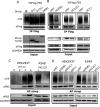Nonproteolytic K29-Linked Ubiquitination of the PB2 Replication Protein of Influenza A Viruses by Proviral Cullin 4-Based E3 Ligases
- PMID: 32265326
- PMCID: PMC7157767
- DOI: 10.1128/mBio.00305-20
Nonproteolytic K29-Linked Ubiquitination of the PB2 Replication Protein of Influenza A Viruses by Proviral Cullin 4-Based E3 Ligases
Abstract
The multifunctional nature of viral proteins is essentially driven by posttranslational modifications (PTMs) and is key for the successful outcome of infection. For influenza A viruses (IAVs), a composite pattern of PTMs regulates the activity of viral proteins. However, almost none are known that target the PB2 replication protein, except for inducing its degradation. We show here that PB2 undergoes a nonproteolytic ubiquitination during infection. We identified E3 ubiquitin ligases catalyzing this ubiquitination as two multicomponent RING-E3 ligases based on cullin 4 (CRL4s), which are both contributing to the levels of ubiquitinated forms of PB2 in infected cells. The CRL4 E3 ligase activity is required for the normal progression of the viral cycle and for maximal virion production, indicating that the CRL4s mediate a ubiquitin signaling that promotes infection. The CRL4s are recruiting PB2 through an unconventional bimodal interaction with both the DDB1 adaptor and DCAF substrate receptors. While able to bind to PB2 when engaged in the viral polymerase complex, the CRL4 factors do not alter transcription and replication of the viral segments during infection. CRL4 ligases catalyze different patterns of lysine ubiquitination on PB2. Recombinant viruses mutated in the targeted lysines showed attenuated viral production, suggesting that CRL4-mediated ubiquitination of PB2 contributes to IAV infection. We identified K29-linked ubiquitin chains as main components of the nonproteolytic PB2 ubiquitination mediated by the CRL4s, providing the first example of the role of this atypical ubiquitin linkage in the regulation of a viral infection.IMPORTANCE Successful infection by influenza A virus, a pathogen of major public health importance, involves fine regulation of the multiple functions of the viral proteins, which often relies on post-translational modifications (PTMs). The PB2 protein of influenza A viruses is essential for viral replication and a key determinant of host range. While PTMs of PB2 inducing its degradation have been identified, here we show that PB2 undergoes a regulating PTM signaling detected during infection, based on an atypical K29-linked ubiquitination and mediated by two multicomponent E3 ubiquitin ligases. Recombinant viruses impaired for CRL4-mediated ubiquitination are attenuated, indicating that ubiquitination of PB2 is necessary for an optimal influenza A virus infection. The CRL4 E3 ligases are required for normal viral cycle progression and for maximal virion production. Consequently, they represent potential candidate host factors for antiviral targets.
Keywords: K29-linked ubiquitination; PB2 replication protein; cullin-based E3 ligases; influenza virus; nonproteolytic ubiquitination; post-translational modification; ubiquitination.
Copyright © 2020 Karim et al.
Figures





References
Publication types
MeSH terms
Substances
LinkOut - more resources
Full Text Sources
Miscellaneous
